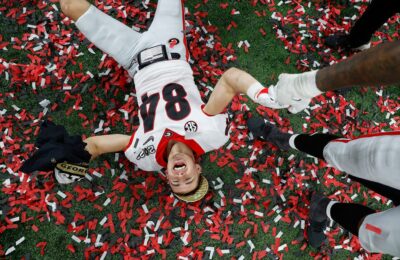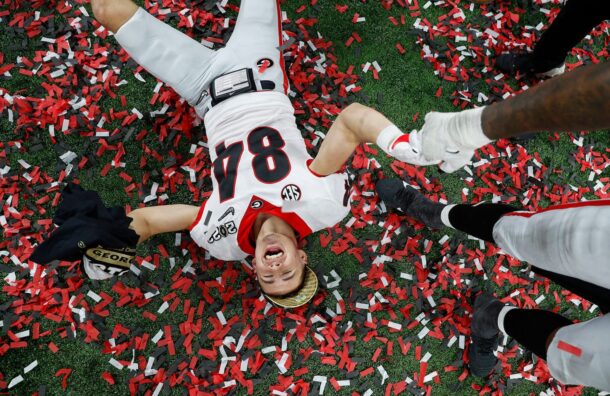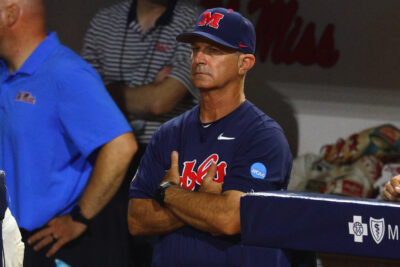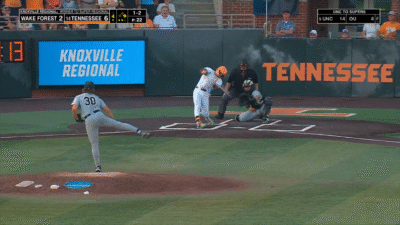Ad Disclosure
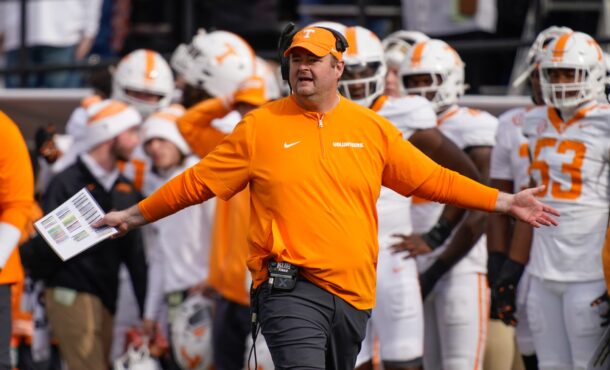
Everyone loves fake trades. In some professional leagues, it feels like fans love fake trades and trade rumors and trade deadlines more than they actually love the games their teams play. I’m not here to judge. I’ve spent far too much time fiddling around in ESPN’s NBA Trade Machine. Who hasn’t?
But trades aren’t a thing in college sports. At least, not officially. And not yet. Perhaps in the future they will be. Some coaches have suggested buyouts for players poached by bigger schools in the transfer portal. If significant and lasting regulation ever comes to the transfer market or the NIL space, maybe a mechanism develops that allows teams to actually trade players.
Until then, we have but hypotheticals. And with the NFL Draft fast approaching, the spring transfer portal spinning up, and everyone trying to keep track of who is where, I had an idea.
What if teams could trade for the 2025 season? If each contending team in the SEC could make 1 trade, who would they target? Which hole would they fill and who would they be willing to sacrifice to do it?
Some ground rules first:
- Intraconference Trades: I am barring teams from trading amongst themselves. The SEC has a rule in place that limits a player’s eligibility if they transfer to another member school during the spring window, and I’m keeping with the spirit of that rule for this exercise.
- Transfers: If a player transferred this offseason, he’s not eligible to be traded.
- Nothing Fancy: We won’t be trading coach contracts or draft picks or any of that gobbledygook that professional teams do to facilitate deals. These will be straight player-for-player(s) transactions.
- Financial Considerations: Until the NCAA gets around to a salary cap, I’m not bothering. The schools with bigger donor bases and deeper pockets have advantages, just like they do in the real world. This also means that cash considerations could be added to proposed deals to sweeten the pot.
Now, let’s get to it.
Alabama Crimson Tide
Alabama receives: TE Justin Joly
NC State receives: RB Daniel Hill, WR Jalen Hall
When Alabama closed out the spring session, it had just 1 scholarship tight end left standing — Jay Lindsey, a redshirt freshman with 1 career catch. Josh Cuevas and Marshall Pritchett both picked up injuries in the spring that sidelined them. Danny Lewis Jr. missed practice with an injury as well. Lindsey got first-team reps during A-Day and was backed up by a host of walk-ons.
When Ryan Grubb and Kalen DeBoer last worked together, Washington’s offense had a trio of NFL receivers to spread the ball around to and it still boasted a tight end who averaged 3 receptions a game. The Huskies’ leading tight end in 2023 had 46 catches for 433 yards and was a legitimate weapon.
A wide receiver was also considered for this spot, but Joly sort of checks both boxes. A UConn transfer in the 2024 offseason, Joly made 43 receptions for 661 yards and 4 scores. He’s a great athlete who breaks tackles and brings in contested catches. Joly slotting in alongside Ryan Williams and Germie Bernard would take some of the pressure off the younger Alabama receivers to be immediate contributors within the offense.
NC State gets a blue-chip running back and a blue-chip wideout to provide immediate relief in areas that have recently been hit by portal entries. Alabama gets a starter for the price of 2 depth pieces, and while Joly is a 1-and-done, those are the kinds of moves teams make when they’re chasing trophies.
Florida Gators
Florida receives: OT Brian Parker II
Duke receives: RB Ja’Kobi Jackson, TE Tony Livingston
With a Heisman Trophy-caliber quarterback, there’s a renewed sense of optimism in Gainesville. Priority No. 1 for Billy Napier and Co. this season will be keeping DJ Lagway upright and protected. So long as the Gators’ second-year passer has time, he can punish defenses with his rocket arm. Florida has depth at running back and tight end to spare in order to fortify an offensive line that also brings back Austin Barber and Jake Slaughter. Barber will hold down the left tackle spot while Parker slots in at right tackle. That duo would be one of the better tackle pairings in the SEC.
Parker has a 2.5% pressure rate allowed over the last 2 seasons, one of the best rates among offensive tackles during that span. In 756 career pass-blocking snaps, Parker has given up just 1 sack, according to PFF. He doesn’t commit penalties, either.
Florida gives up a tight end from its 2-deep and a co-starter at running back to fortify the offensive line, but the Gators have one of the deeper backfields in all of college football. Jadan Baugh is ready for a featured role right away. Treyaun Webb and KD Daniels have shown promise. Duke gets a proven starter at tailback to pair with new quarterback Darian Mensah in the backfield, allowing Jaquez Moore to ease back into the fold following a 2024 season lost to injury.
Georgia Bulldogs
Georgia receives: Edge Mikail Kamara
Indiana receives: WR London Humphreys, DL Nasir Johnson, DE Joseph Jonah-Ajonye
The most important position on the defensive side of the football is notably lacking for Georgia right now, both in terms of star power and experienced depth. The SEC is chock-full of game-changing edge defenders, but NFL departures have drained the talent pool in Athens over the last few years. I’ve got Georgia taking a swing for the fences and landing an elite talent.
Kamara jumped from the Sun Belt to the Big Ten last season, following coach Curt Cignetti from James Madison to Indiana, and proving more than up to the challenge. Though his size (6-1) won’t wow NFL scouts, he’s plenty sturdy enough with tools to beat tackles. He led all FBS edge rushers last season with 67 QB pressures and finished 14th nationally in sacks (10). If he can hang in the Big Ten, he can do damage in the SEC. (We saw another Big Ten import from the state of Indiana dominate the SEC last season at Texas A&M.)
The Hoosiers get some massive bodies and former blue-chip prospects to add to their defensive line, and land a big-play threat at receiver who can step into the slot and fill an immediate need in the aftermath of a season-ending injury.
LSU Tigers
LSU receives: DL Domonique Orange
Iowa State receives: DL Ahmad Breaux, Edge Kolaj Cobbins, Edge CJ Jackson
The interior of the defensive line was LSU’s most pressing concern last offseason, and it remained a point of emphasis this spring. Jacobian Guillory is coming off an Achilles injury. Dominick McKinley and Breaux were asked to play early in their careers. The Tigers’ only portal addition at the position thus far has been former Texas backup Sydir Mitchell, a player with immense size but little in the way of production.
In a defensive line swap, LSU gets an outstanding talent to plug the hole in the middle of its defense and Iowa State — which has to rebuild its defensive line this offseason — gets a trio of blue-chip youngsters who can fill immediate roles.
The Tigers are well-stocked at defensive end. The middle has to get figured out. Per Game on Paper, LSU ranked 94th last season in EPA per run allowed. They gave up a ton of chunk gains on the ground and didn’t have a player who could stuff plays at the line. The 6-4, 325-pound Orange has the size to play in the SEC and plenty of production. He has 42 quarterback pressures in 3 seasons with the Cyclones and produced 17 stops last fall, one of the top marks among interior Big 12 defensive linemen, per PFF.
Missouri Tigers
Missouri receives: OL Caleb Tiernan
Northwestern receives: WR Marquis Johnson, OL Jayven Richardson
Northwestern made a splash move in the transfer portal landing quarterback Preston Stone from SMU, but Stone can only do so much. Northwestern has to replace each of its top 3 wideouts and its top 2 tight ends from last season. The transfer portal has brought help on the offensive line but skill talent is typically hard to come by in Evanston. Mizzou gives up a likely starter at receiver and a left tackle competing for a starting job to solidify the left side of its line.
With Tiernan joining the picture, Cayden Green can remain at left guard, Keagan Trost takes the right tackle spot, and a line that has to replace 3 starters from 2024 becomes an immediate strength of the team.
The 6-7 Tiernan was the highest-graded pass-blocker in the Big Ten last season, with an 88.9 grade from PFF. He has 4 years of experience at the college level and would be a fantastic blindside protector for new quarterback Beau Pribula.
Ole Miss Rebels
Ole Miss receives: RB Jordan Lyle
Miami receives: WR Izaiah Hartrup
When Ole Miss lost Quinshon Judkins to the transfer portal, the room looked like it could be fine. Henry Parrish and Ulysses Bentley were a more-than-capable 1-2 punch on paper, but Parrish saw his season cut short by an injury, Bentley was buried on the depth chart, and Ole Miss struggled to get consistency from its ground game. The 2025 running back room has 4 newcomers and a player coming back from injury, so there are bodies, but is there a bell cow?
If 2025 is going to be different — and it needs to be with Ole Miss moving to a new quarterback — the Rebels need someone to emerge. In swapping the veteran Hartrup for Miami’s RB2, the Rebels grab a high-upside back who can run with the lead job.
Miami has loads to replace at receiver and Hartrup’s starting experience would give the ‘Canes a vet to bring along a young room. Lyle gets out from behind Mark Fletcher after showing more than enough last season. In 12 games last season, Lyle ran for 400 yards and 4 scores at 7.4 yards per carry. He forced 14 missed tackles on 54 carries and had a 17% explosive run rate.
South Carolina Gamecocks
South Carolina receives: OL Logan Jones
Iowa receives: DB Vicari Swain, OL Tree Babalade
Help in the secondary and fortification at tackle are the top priorities for Iowa right now. South Carolina’s most pressing concern is on the interior of the offensive line, where it has to replace all 3 starters between the tackles. Babalade can play all along the line for Iowa and Swain is pushing for a starting job at corner.
South Carolina is in good shape in the secondary. Losing Swain opens a spot for NC State transfer Brandon Cisse to enter the starting lineup and slides Jalon Kilgore into the nickel spot. Getting Jones to take over at center lets Troy transfer Boaz Stanley work as a first guy off the bench. He played right tackle and center for Troy last season, and that versatility is valuable.
With LaNorris Sellers and Rahsul Faison, South Carolina has the talent to produce an elite rushing attack. Jones is a dominant blocker in the run game. According to PFF, he was the highest-graded center in the power conference level last season.
Tennessee Volunteers
Tennessee receives: QB Josh Hoover
TCU receives: QB George MacIntyre, RB Peyton Lewis
Following a drama-filled breakup with quarterback Nico Iamaleava, a conference title contender in the SEC is left without a starting quarterback heading into the summer. TCU’s Hoover feels like a natural fit for the offense Josh Heupel wants to run.
A 6-2 quarterback, Hoover set TCU’s single-season passing record last season with 3,949 yards. The output was slightly a product of TCU’s nonexistent run game, but Hoover’s efficiency was more interesting. He completed 66.5% of his throws and tossed 27 touchdowns against 11 picks. Hoover has been too willing to put the ball in danger at times, but he’s a quick-blinker who rarely misses on the short stuff and has an excellent deep ball. Per PFF, Hoover had a 94.2 grade on throws of 20 yards or more, with an adjusted completion percentage of 54.5% and 17 big-time throws against 5 turnover-worthy plays. His adjusted completion rate on deep throws ranked sixth nationally among qualified FBS passers.
There’s zero reason for TCU to give up its starting quarterback for a pair of youngsters with little starting experience. Tennessee would have to throw some cash at TCU or add a couple of extra pieces in positions of need for the Horned Frogs to come to the table. But TCU offered MacIntyre out of high school and needs a running back following the departure of Cam Cook. If I’m calling the shots for Tennessee and I’m looking for my Iamaleava replacement, I’m flying to Fort Worth and throwing whatever I need to at TCU to bring Hoover back with me.
Texas Longhorns
Texas receives: TE RJ Maryland
SMU receives: RB Jerrick Gibson, WR Jaime Ffrench
Texas was searching for a tight end in the winter transfer window and missed out on Purdue transfer Max Klare — one of the best returning tight ends in all of college football. Now, the Longhorns grab their TE1 from just down the street. Giving up an elite wideout recruit and a promising tailback to grab Maryland from SMU is a steep price, but Maryland is like Klare in that he’s one of the best at his position in all of college football.
Texas has one of the best tailback tandems in the country in CJ Baxter and Quintrevion Wisner — if not the best. The receiver group is in a transition year, but there’s plenty of talent. With Gunnar Helm leaving, Texas has a massive hole at tight end. Helm set single-season program records last year for receptions (60) and receiving yards (786) by a Texas tight end. He’s also not the only tight end Texas lost this offseason.
Maryland was trending toward a fantastic season before an ACL tear sidelined him for the year. In 7 games, he had 24 receptions for 359 yards and 4 scores. He’s not the best in-line blocker, but Spencer Shannon can fill that role without having to step outside his comfort zone as a go-to pass-catcher. Maryland was one of SMU’s favorite targets in the pass game when healthy and could be that for Texas quarterback Arch Manning.
Texas A&M Aggies
Texas A&M receives: DB Bud Clark
TCU receives: DB Bryce Anderson, WR Ashton Bethel-Roman
The Aggies have a glut of similarly sized receivers and can afford to lose Bethel-Roman in order to upgrade at safety. Clark was one of the very best safeties in the country last season, having a massive bounceback year from a disappointing campaign in 2023.
Clark had an 89.8 overall defensive grade from PFF, had an 87.0 grade as a tackler, picked off 3 passes, and knocked away 3 more. Clark also had 67 tackles. His ball skills are strong and his improvement as a tackler makes him an obvious fit in Texas A&M’s defense.
The Aggies were atrocious in the secondary as the 2024 season wound down. Coach Mike Elko said last season that Texas A&M didn’t “understand” how to play zone and couldn’t defend the forward pass. Defensive coordinator Jay Bateman stated during the spring that serious schematic adjustments have been made. The top 3 options at safety from last season are all back, but that doesn’t guarantee improvement. Adding Clark does.
Derek Peterson does a bit of everything, not unlike Taysom Hill. He has covered Oklahoma, Nebraska, the Pac-12, and now delivers CFB-wide content.


